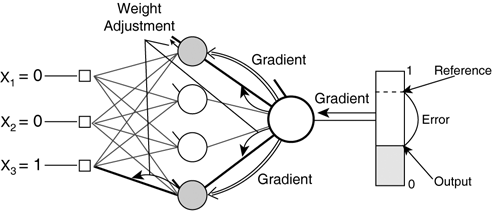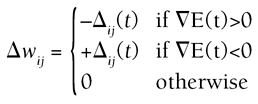Training Algorithms
| The mathematical background in MLPs does provide one advantage: They can be trained. Just like for perceptrons with single layers, the task of training an MLP is fundamentally about numeric optimization. The ideal value of each weight must be found to minimize the output error. This is slightly more challenging because it's harder to determine the necessary adjustment to correct the weights (because the gradient of the error cannot be computed directly). This explains the additional complexity of the training algorithms. Back PropagationBackprop is the process of filtering the error from the output layer through the preceding layers. This was developed because of problems with the original perceptron training algorithms: They were unable to train the hidden layers. Back propagation is the essence of most MLP learning algorithms, because it allows the gradient to be determined in each weight (so they can be optimized). Informal ExplanationFor the last layer, the error of the output is immediately available, computed as the difference between the actual output and the desired output. Using the exact same principles as for the perceptron, the gradient of the error in each weight can be found. The gradient descent algorithms can use the slope of the error to adjust the weights in the last layer. For hidden layers, the error is not immediately available because there is no reference to compare the output to! Instead, we notice that some hidden neurons are connected to output neurons whose error is known. The error in the output must partly originate from the hidden neurons. By propagating the error backward through the neural network, it's essentially possible to distribute the blame for the error on predecessor neurons. This back-propagation process, shown in Figure 19.5, propagates the error gradient. The error gradient of a hidden unit is the weighted sum of the error gradients in the output units. The weights of the connections determine hidden error gradient from known processing units. Figure 19.5. Backward propagation of the error throughout the layers, distributed from the output via the weighted connections. This can be understood as a recursive definition of the error gradient. No matter how many layers are present, we can work backward from the outputs and compute all the error gradients in the processing units. Then, using the same technique as for perceptrons, we can compute the gradient in each of the individual weights. Steepest descent or any other gradient based optimization is then applied to the weights to adjust them accordingly. Formal ProofThis section is only intended for those with an interest in the underlying details of training. We're trying to find the derivative of the error with respect to the weight connecting unit i to unit j, denoted We start with the third term on the right, the derivative of the net sum of unit j with respect to the weight The second term Finally, the first right-side term is left For those units j that are not connected straight to the MLP's output, the term is computed recursively in terms of the units k that are along the connection toward the output. It's the sum ( In general, it is useful to use an easier notation to implement the algorithm. If we define the following Then the gradient of the error relatively to the net sum dj can be computed depending on its position in the network: This emphasizes the need for a backward-propagation process, where dj is computed for each unit of each layer depending on the previous unit's k. Backprop AlgorithmThere is a simple training algorithm based on the application of these equations; incremental training is applied to a set of examples. The method is known as backprop, but in fact the actual backward propagation is only one part of the process. Back propagation is the first stage of the algorithm, used to compute the gradients in each of the neurons (and then the weights later). The outline in Listing 19.2 is at the core of all the gradient-based techniques, because it actually computes the gradient. Now the second stage of the backprop algorithm performs steepest descent to the weights (see Listing 19.3). (This is where learning happens.) Listing 19.2 Backward-Propagation Algorithm Used to Compute the Gradient of the Error in Each of the Units# compute the gradient in the units of the first layer for each unit j in the last layer delta[j] = deriv_activate(net_sum) * (desired[j] - output[j]) end for # process the layers backwards and propagate the error gradient for each layer from last-1 down to first for each unit j in layer total = 0 # add up the weighted error gradient from next layer for each unit k in layer+1 total += delta[k] * weights[j][k] end for delta[j] = deriv_activate(net_sum) * total end for end for Listing 19.3 Steepest Descent on the Error Gradient in Each of the Weights for each unit j for each input i # adjust the weights using the error gradient computed weight[j][i] += learning_rate * delta[j] * output[i] end for end for The rule used to compute the step for each weight Dwij is known as the generalized delta rule, an extension of the delta rule used to train standard perceptrons. The learning rate h is a small constant set by the engineer. dj is the gradient of the error of unit j relative to the net sum zj. This is used to compute the necessary change in the weights to perform gradient descent. Quick PropagationQuickprop is a batch technique based on a combination of ideas. First, it exploits the advantages of locally adaptive techniques that adjust the magnitude of the steps based on local parameters (for instance, the nonglobal learning rate). Second, knowledge about the higher-order derivative is used (such as Newton's mathematical methods). In general, this allows a better prediction of the slope of the curve and where the minima lies. (This assumption is satisfactory in most cases.) Quickprop TheoryThe procedure to update the weights is very similar to the standard backprop algorithm. The gradient of the error in each weight is needed, denoted This value is necessary for the current epoch t (a learning period) and the previous one t-1 denoted In practice, this proves much more efficient than the standard backprop on many problems. However, some of the assumptions about the nature of the slope can prove problematic in other cases. This really depends on each problem, and can be tested by comparing this algorithm's performance with the two others. Implementing QuickpropTo implement this, two more arrays are needed for the step and the gradient, remembering values from the previous iteration. Because it's a batch algorithm, all the gradients for each training sample are added together. The backprop algorithm can achieve this by accumulating dj at each iteration. These values will get reset only when a new epoch starts (that is, when the iteration over all the samples restarts). The second part of the backprop algorithm is replaced; we use the new weight update rule rather than steepest descent (see Listing 19.4). Listing 19.4 The Weight Update Procedure as Used by the Quick-Propagation Algorithmfor each unit j for each input i # compute gradient and step for each weight new_gradient[j][i] = -delta[j] * input[i] new_step[j][i] = new_gradient[j][i] / (old_gradient[j][i] new_gradient[j][i]) * old_step[j][i] # adjust the weight weight[j][i] += new_step[j][i] # store values for the next computation old_step[j][i] = new_step[j][i] old_gradient[j][i] = new_gradient[j][i] end for end for Given a working backprop algorithm, the quickprop variation does not take long to implement and test. Resilient PropagationRProp is another batch algorithm that updates the weights only after all the training samples have been seen [Riedmiller93]. The key idea is that the size of the step used to update the weights is not determined by the gradient itself, which removes the major problems associated with steepest descent techniques. RProp TheoryThe algorithm introduces the concept of update value Dij, which is used to determine the step Dwij. It's important not to confuse the two, and the notation chosen by Riedmiller and Braun does not help. The update value is used to determine the step: This is relatively intuitive to understand. If the slope goes up, we adjust the weight downward (first case). Conversely, the weight is adjusted upward if the gradient is negative (second case). If there is no slope, we must be in a minima, so no step is necessary (third case). This equation is needed to compute the new update value: h+ and h are constants defined such that 0<h <1<h+. Informally, the size of the step is increased (multiplied by h+) if the gradient maintains the same direction (first case). The step size is decreased (multiplied by h ) if the gradient changes sign (second case). Otherwise, the step size is left untouched if the gradient is 0. Implementing RPropOnce again, we need extra arrays with the previous error gradients as well as the previous update value for each weight. As a batch algorithm too, the first loop to compute the sum of the gradients is the same as quickprop's. Then, the second stage of the algorithm is applied to update the weights, as shown in Listing 19.5. Listing 19.5 The Weight Update Procedure Behind the Resilient-Propagation Algorithmfor each unit j for each input i # first determine the gradient in the neuron new_gradient[j] = delta[j] * input[i] # analyze gradient change to determine size of update if new_gradient[j] * old_gradient[j] > 0 then new_update[j][i] = nplus * old_update[j][i] else if new_gradient[j] * old_gradient[j] < 0 then new_update[j][i] = nminus * old_update[j][i] else new_update[j][i] = old_update[j][i] # determine which direction to step in if new_gradient[j] > 0 then step[j][i] = -new_update[j][i] else if new_gradient[j] < 0 then step[j][i] = new_update[j][i] else step[j][i] = 0 # adjust weight and store values for next iteration weight[j][i] += step[j][i] old_update[j][i] = new_update[j][i] old_gradient[j][i] = new_gradient[j][i] end for end for This is slightly trickier to implement, but is still classified as a simple task after backprop has been written! |
EAN: 2147483647
Pages: 399






 ) of the error gradient relative to the output of k
) of the error gradient relative to the output of k 






